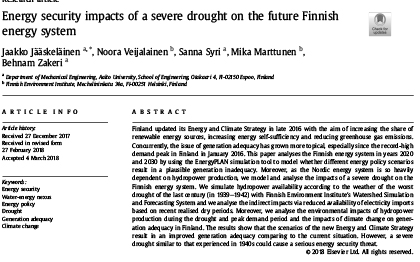Finland updated its Energy and Climate Strategy in late 2016 with the aim of increasing the share of renewable energy sources. increasing energy self-sufficiency and reducing greenhouse gas emissions. Concurrently. the issue of generation adequacy has grown more topical. especially since the record-high demand peak in Finland in January 2016. This paper analyses the Finnish energy system in years 2020 and 2030 by using the Energy PLAN simulation tool to model whether different energy policy scenarios result in a plausible generation inadequacy. Moreover. as the Nordic energy system is so heavily dependent on hydropower production. we model and analyses the impacts of a severe drought on the Finnish energy system. We simulate hydropower availability according to the weather of the worst drought of the last century (in 1939 e 1942) with Finnish Environment Institute`s Watershed Simulation and Forecasting System and we analyses the indirect impacts via reduced availability of electricity imports based on recent realized dry periods. Moreover. we analyses the environmental impacts of hydropower production during the drought and peak demand period and the impacts of climate change on generation adequacy in Finland. The results show that the scenarios of the new Energy and Climate Strategy result in an improved generation adequacy comparing to the current situation. However. a severe drought similar to that experienced in 1940s could cause a serious energy security threat.
 Iran Energy News Oil, Gas, Petrochemical and Energy Field Specialized Channel
Iran Energy News Oil, Gas, Petrochemical and Energy Field Specialized Channel




